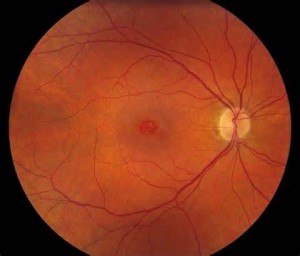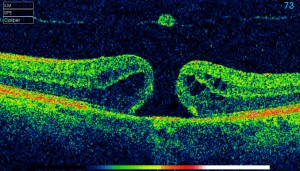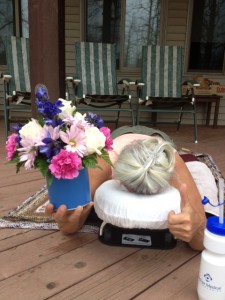The old adage ‘you never know what you’ve lost til it’s gone’ is never more true than when it applies to you. Eyesight is a precious gift and for a golfer, great vision is an advantage, good vision is useful, poor vision is detrimental, and no vision is….well, scary.
Blessed with great eyesight for all my life, about nine weeks ago it all changed when the vision in my right eye suddenly became blurry and distorted. Not just ‘I need glasses’ blurry, but lines of words pinching together, people’s faces resembling aliens, road signs disappearing, and brake lights on cars in front vanishing or losing their color. Thinking I may have scratched my eye or did something minor, I let it go for a couple days. When reading and writing became almost impossible and nothing improved, I went to the eye doctor immediately.
My father was plagued with poor vision the last 20 years of his life. He had the triple whammy: glaucoma, cataracts, and macular degeneration. I took him on countless doctor and ophthalmologist visits and watched as these doctors probed, cut, and injected solutions into his eyes. He’d even had corneal transplants but nothing could stop the slow deterioration of his eyesight until he was virtually blind by his late 70’s. But he never complained. He still played golf with me watching the ball. Not a problem because he was always dead straight, down the middle. Mom also had eye issues but she passed away when I was 28 so I never really knew what her problems had been, though I suspect diabetes played a role and caused some partial blindness. Eye problems are often hereditary.
So there I was, taking all kinds of visual field tests I knew I was flunking, thinking the worst. Just two years ago I’d had a complete eye examination and the optometrist was praising me about my eye health, citing beautiful images of my crystal clear inner eye parts – the vitreous gel, the retina, the strong, red blood vessels that resembled I-75 on road maps.
“You must exercise,” said Dr., John Poggiolo, “because your eyes’ blood vessels are strong and healthy.” He knew I played golf……and walked. “I’ll bet that’s why your eyes should serve you well for a long time.”
Comparing the scans from 2012 and 2014, however, even I could see the shadow on my right eye. “What is that?” I asked.
The look on his face was one you never want to see your doctor make. “I’m not sure, but we need to get an ultrasound of this. It is either a bit of serous retinopathy or a macular hole; and I hope it isn’t a macular hole.” Of course I looked up both of those conditions and I did not want it to be a macular hole either….mostly because of the method of recovery: facedown 24/7 for days…..or weeks.
I came back the next day for more tests. Another scan produced the diagnosis I did not want: macular hole. Two hours later I was with a retina specialist.
To understand how macular holes occur, one needs to understand some simple eye anatomy. The macula, where holes can develop, is a very small spot in the center of the back of the eye, or retina. Light focuses to a sharp point at the macula, which is the only area of the eye that sees crystal clear, color vision, and is necessary for recognition, driving, writing, and also seeing what’s ahead on the fairways and greens. Without a working macula, your fine vision is lost. Not too many years ago, a macular hole could not be fixed; the hole would generally get bigger until you could not identify much of anything. The eye would not be blinded, but for all intents and purposes, not useful. Plus, the damaged eye compromises your other eye. For me, it wasn’t long before the process of one good eye and one bad eye trying to focus, did not succeed, and eye fatigue set in. It was difficult to read, write, or work on a computer, and even to watch TV. It is like watching a movie in the theater and the patrons are yelling at the projector operator to ‘focus, focus!!’….only, he already has.
Sometimes macular holes seal themselves, but I could see the tear on the retinal scan. Surgery was a given and I walked out of the office realizing I’d no longer be a surgeon virgin. I would have scheduled the procedure immediately, but with Holy Week approaching and my duties as Director of Music at St. Basil church in Eastpointe, MI many, I opted for the day after Easter. My surgeon, retina specialist Dr. Joel Miller, suggested that waiting two or three weeks would not matter much – but two or three months probably would. But who wants to drag out the waiting when you know something is seriously wrong? Those next 19 days ran the gamut of ‘everything will be fine’ to ‘what if there are complications and it cannot be fixed?’ or ‘what if I go blind in that eye’? And then you worry about all the things you’ve done without thinking – driving, writing, reading, playing golf, watching movies, walking, snorkeling and diving – and realize that those were never a given…..merely a privilege. Then there’s the matter of anesthesia. I’d never had it before and all you can think about are the rare cases of mistakes causing permanent brain damage or coma. As I pondered all those possibilities, I quickly tried to toss them aside. Normally I’d scour the internet for all the information I could find – which usually turns up the bad experiences – but instead decided it served no purpose whatsoever. I was already given a lot of details by the retina specialist’s office and that’s what I’d refer to.
What caused my problem was probably a matter of genetics or heredity….and maybe a tiny bit of the aging process. A membrane in the right eye’s vitreous gel became sticky and attached to the macula, which is located in the top layer of the retina. The membranes normally float around harmlessly, but in my case, decided to depart and take a piece of my macula along with it, hence the tear. This creates a hole and the vitreous fluid seeps in, which is what caused the watery-like blurred and distorted vision. The retina can only reflect back what it sees – and what it saw was this ‘V’ formation caused by the interruption of the surface. Nothing can fix that, no powerful reading glasses, no magnifying glass, because the mechanism isn’t working.
Surgery to fix a macular hole is fascinating. The doctor inserts small surgical instruments around the cornea and looks through a powerful microscope to identify the hole then gently strips away the offending membrane. He then closes the hole, usually putting the torn macula tissue back if it is still attached, and seals the repair with a dab of tissue glue. There are no stitches. He then injects a small gas bubble at the site. This holds the repair in place. The significance of the gas bubble is what makes the recovery so uncomfortable: for the repair to hold, physics and gravity play a part. Lying facedown allows gravity to keep the macular eye tissue down, connected to the gas bubble, which rises to settle at the repair site. The 24/7 facedown position must be assumed until the hole is completely closed and healed. If you get up, put your head back, or lie on your back, you risk the bubble shifting and the hole re-opening, thus lengthening recovery time. Impossible to do, you say? Difficult, certainly, but when that’s what stands between you getting your vision back – or not – you do it. Uncomfortable, boring, endless, yes – but necessary; however, there are ways to make things more pleasant.
Preparing for the surgery, called a vitrectomy, involved ordering equipment I’d use during that, as I called it, ‘facedown-butt-up’ recovery. There are companies which specialize in equipment designed for this and other retina surgeries. You can order a package consisting of a chair, ‘wedge’ bed, travel block, and tabletop work station. Golfers will be familiar with the special massage chairs sometimes brought out during charity events to provide participants 10-minute ‘chair massages’. This particular chair has a mirror set-up so you can watch movies or endless reruns of Law and Order or Deadwood on TV, at least with your good eye. The wedge bed is a cushion placed on your bed with a headrest allowing an opening for your face. The wedge slants so you can lie on your stomach and your legs point downward. The travel block allows you to ride in a car, usually from the hospital and to and from follow-up doctor’s appointments. The block sits on your lap with a headrest on top. I almost kissed Dr. Miller when he told me I could get up every hour for a few minutes to stretch, eat, and perform other natural duties…..but he added it was best to walk with your head down. You quickly figure out this facedown-butt-up stuff is no joke.
The morning of surgery called for an earlier wake-up call than any golf tournament tee time I’ve ever had. Riding in, I recalled a 7am tee time for the USGA Mid-Am I competed in at Greg Norman’s Old Marsh CC in Florida in October of 1992. It was still dark at 6:30 when I wanted to warm up on the range. The dawn was barely breaking when my first drive was in the air at 7am. My arrival time at the Straith Hospital for Special Surgery in Southfield, Michigan was 5:30am. I signed my life away, and health histories were taken. The staff was surprised by the fact that I’d had no other surgeries, chronic conditions (except thyroid, a common one), no high blood pressure, or other maladies. They said people do not realize how much it matters that you are otherwise healthy because there are less complications and the recuperation period is easier. And this is one of the reasons I am such a fanatic about being able to walk a golf course. It contributes to general health and well-being, certainly a selling point to increase golf numbers within demographics that care about fitness and health. The golf industry often misses the point on the cart issue. The anesthesiologist popped in and gave me the menu: light sedation through my IV, then I’d go under with a small dose of propofol (Michael Jackson’s downfall) for a few minutes as they prepped me for surgery. Then, they’d wake me up for the actual procedure. WHAT? Apparently when totally under, patients can move or snore, which isn’t beneficial when doctors are performing micro-surgery. She said I’d hear music, talking, and I’d see colored lights (but please, no heavenly light or angelic choirs) yet would be comfortable and feel no pain….and that I’d likely not remember anything. She got most of it right, except for the remembering part. I do recall hearing the doctors talk, seeing reds and yellows and strands of things, and thinking, ‘wow, this does not hurt’. In fact, the surgery itself – what I was most dreading – was the easiest part of the whole ordeal. I do not remember being wheeled back to the recovery room but do know the doctor said all went well except for one small issue. As he was trying to strip the membrane, it tore a slightly bigger hole. A common problem, Dr. Miller said, and all it meant was perhaps a longer facedown recovery time than he had originally promised, at 48-72 hours instead of 24-hours. I figured if that was the only problem I would have, I was lucky. One other repercussion of any eye surgery is the possible development of cataracts; the longer facedown position can minimize this.
The next three days were spent with my head down, which is far different from the erect posture I normally assume. I actually felt fine, there was no pain, but back and neck cramps from the facedown position made life a bit uncomfortable. And I could not wait to get the pirate-eye patch off during the follow-up appointment the next day. When it came off, the gas bubble covering my eye was now visible, a very weird phenomenon; imagine the bubble from a construction level bobbing around in your eye. I could not see objects in the distance, but bringing them directly under my eye created a magnifying glass effect and I could see very clearly, up close. Five days later, the bubble was small and I could see over it. I was still getting reflections off the bubble, which looks like rays shooting up, and things are a little cloudy, but I was able to see.However, if I tried to look down, write, or prepare food, I had double vision. The bubble disappeared a couple days later and my vision is continually improving as time goes on. Released from the facedown confinement, I felt as though a 1,000-lb. weight had been lifted. I don’t know if my vision will return to normal, but it clearly is better than it was. My biggest problem will be to take things slowly and not strain my eyes….and remember to take my steroid eye drops, a process I remember so well with Dad.
What I’ve learned from all of this is to never take your body for granted. When you have good health and everything works correctly, you become complacent. It is only when something goes awry and you risk losing it, that the appreciation factor sets in. Do yourself a favor and take advantage of every screening opportunity your health insurance allows. If something is wrong, don’t delay. Get it checked right away. And with your eyes, if you see strange things going on, DO NOT WAIT. Fortunately my problem was fixable, but if I had dilly-dallied too long, my entire retina could have been at risk. For a golfer, your sight is most precious. I understand that there are blind golfers who do extremely well, but given the chance, I’d guess even they would like to be able to see.
In the words of that eternal song written by ne’er-do-well John Newton in the 1700’s – which I’ve sung thousands of times – ‘I once was blind, but now I see.’



